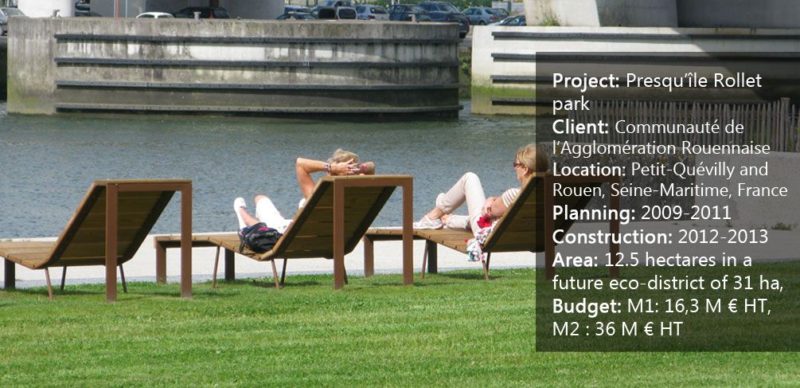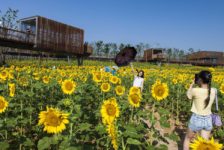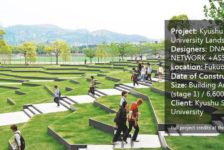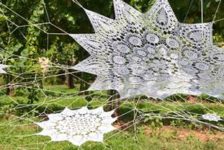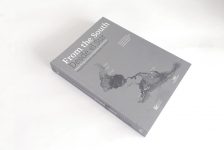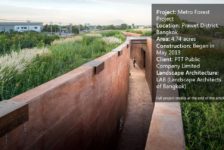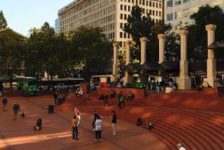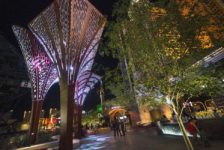Presqu’île Rollet Park, by Atelier Jacqueline Osty & associés, Petit-Quévilly and Rouen, Seine-Maritime, France. As the industry of coal storage begun to lose importance in the past years previous port sites turned into wastelands, but they did not lose their importance or dynamism. Cities became denser so that these sites along rivers and ports became focal points for development and investment. As part of the project, Seine Ouest-Rive Gauche and being in direct relationship with two major elements – the Seine river and the eco-district – Presqu’île Rollet Park designed by Atelier Jacqueline Osty & associés draws the tableau of restoration of nature in the city. Furthermore beyond the park’s function, it shows the reconciliation of the city of Rouen and of the Flaubert district with the river. The design of this park places value on the identity by retaining former materials and elements of the site.

Masterplan of Presqu’île Rollet Park. Image credit: Atelier Jacqueline Osty & associés
Presqu’île Rollet Park
How to recapture a river bank? The banks of the river Seine located in the neighborhood of the Flaubert eco-district developed on the site of a former port and industrial wasteland. Thus, the river banks struggled with soil contamination. Because of this, and the desire for nature, different steps had to be found to overcome the present difficulties of creating biodiversity and restoring the river banks.

Presqu’île Rollet Park. Photo credit: Atelier Jacqueline Osty & associés
The renewal of the natural banks begun with planting 100,000 native trees constituting a forest mound. The hill contains the volume of soil excavated during the work on the river banks. The artificial “ecological niche” helps develop a wildlife refuge and an island with an original shape reflecting the natural scale of the Seine meander. Through the direct use of green plants, the contamination of the soil is reduced through the process of phytoremediation.

Presqu’île Rollet Park. Photo credit: Atelier Jacqueline Osty & associés
The second strategy of the recapture was the design of the park landscape. The platform lying alongside the water and the industrial quays represents an ideal place for events, together with the large clearances intended to accommodate festivities. From the Gustave Flaubert Bridge, the large walk in the river park takes you through different “paysages” (landscapes).

Presqu’île Rollet Park. Photo credit: Atelier Jacqueline Osty & associés
At the rear of sheds 106, 107 and 108 extends the “Jardin du rail” (garden of the rail), a playground and two wooden structures for children, and a “pétanque” area (a traditional game from Provence), a large flowery meadow for relaxation and leisure. This particular strategy also accounts for the future through careful planning. A concert hall and a business incubator will in future add to the recapture of the river banks.

Presqu’île Rollet Park. Photo credit: Atelier Jacqueline Osty & associés
The imprint of the industry on the city of Rouen had major negative effects such as contaminated soil. This is especially true of the nature in the city. The restoration of the landscape, biodiversity, and river banks resulted in the Presqu’île Rollet Park. The development of the banks of the Seine River is the first transformation of the district. The improvement of the quality life for locals, as well as tourists, is tremendous.

Presqu’île Rollet Park. Photo credit: Atelier Jacqueline Osty & associés
Along the 2km long promenade along the Seine, the alteration between designed functionality and “rewilded” nature makes the perfect combination for inspirational walks, sport, and relaxation. Therefore the missing link between the people, river and nature was restored through this peninsula-park that also became the natural neighborhood of the Flaubert eco-district.

Presqu’île Rollet Park. Photo credit: Atelier Jacqueline Osty & associés
The integration of some existing raw materials into the former wasteland has a wide range of benefits. The so-called new-life reuse of the former railway tracks evokes the spirit of the site– the dynamic of a port and of the water. These are embed in the soils as the grass lashes and reminds of another successful project, the Highline in Manhattan. Not only the railway but also reused paving stones and concrete becomes an essential part of the park.

Presqu’île Rollet Park. Photo credit: Atelier Jacqueline Osty & associés
The reuse of the pavement saves money and resources. It also limits the environmental impact of the construction. The benefits are extended to the community too. The reused elements confer identity and preserve the special character of the port. The people living in the new eco-district can have a direct tangent to the past of the site.
Related Articles:

Presqu’île Rollet Park. Photo credit: Atelier Jacqueline Osty & associés
The successful recapture – planting, designing and planning – of the Seine River banks synchronize with the reconciliation of the city river relationship and nature restoration. Where biodiversity was created because it had been totally lost, the relationship between people and the river has been restored and reconciled because it was never absent.

Presqu’île Rollet Park. Photo credit: Atelier Jacqueline Osty & associés

Presqu’île Rollet Park. Photo credit: Atelier Jacqueline Osty & associés
The old island that was used for storage of coal became a natural island with its forest hill, meadows, and promenade, where it is possible to discover new and unique views of the city and harbor. As a kind of ecological laboratory and a potential environmental workshop the Presqu’île Rollet Park goes beyond park functions. The reuse of materials shows an environmental awareness that can further change attitudes of local people.

Presqu’île Rollet Park. Photo credit: Atelier Jacqueline Osty & associés
Presqu’île Rollet park
Team: Prime Design Consultant, Landscape architect: Atelier Jacqueline Osty & associés (Jacqueline Osty, Loic Bonnin, Gabriel Mauchamp, Fanny Guimet) With ATTICA, urbanist, EGIS, Engineer consultant, BURGEAP, Environment engineering, Michel Boulcourt, forest plantation consultant
Client: Communauté de l’Agglomération Rouennaise
Location: Petit-Quévilly and Rouen, Seine-Maritime (76), France
Planning: project studies: 2009-2011, construction: 2012-2013
Area: 12.5 hectares in a future eco-district of 31 ha,
Budget: M1: 16,3 M € HT, M2 : 36 M € HT
Awards: “Grand prix d’architecture et d’urbanisme de Haute-Normandie” 2014, Prix de l’aménagement
Program: Redevelopment of the Seine’s bank as part of the project Seine Ouest-Rive Gauche, within the eco-district Flaubert
Show on Google Maps
Recommended Reading:
Article by Ruth Coman Return to Homepage
Published in Blog












